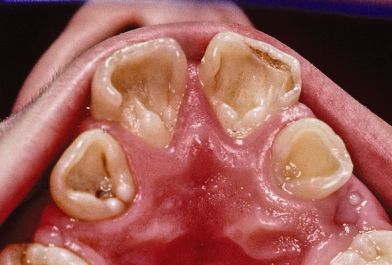42
Disorders of Tooth Shape and Size
Changes in Size and Shape
Morphological anomalies occur during the morphodifferentiation stage of tooth development. Proliferation of the cells of the inner enamel epithelium results in changes in form of the teeth. While some anomalies have an hereditary component, most occur sporadically and the cause is unknown.
Macrodontia and Microdontia
Macrodontia (Fig. 42.1)
Isolated macrodontia is associated with double teeth (see below) but generalised macrodontia is extremely rare. It may be associated with hormonal abnormalities such as pituitary giantism or developmental anomalies including hemifacial hyperplasia or KGB syndrome.
Figure 42.1 Generalised macrodontia is uncommon. There is usually an accentuation of all the features of the crown particularly the marginal ridges giving the incisors a “shovel-shaped” appearance.

Management
Interproximal stripping may be possible depending on the size and position of the pulp chamber, but if the tooth is too large then extraction may be the only alternative followed by orthodontics and/or prosthodontic replacment.
Microdontia
Microdontia is commonly associated with cases of hypodontia, particularly with ectodermal dysplasia (Fig. 42.2). It is rare in the primary dentition and, while smaller teeth are more commonly found in females, macrodontia occurs more frequently in males. As with missing teeth, the last tooth in each series tends to be smaller in size. Generalised microdontia is extremely rare.
Figure 42.2 Microdontia and conical teeth characteristically associated with ectodermal dysplasia.

Management
- Composite resin veneers or build-ups.
- Orthodontic alignment.
Peg Laterals
These are more commonly found in females, and are often associated with absence of the contralateral tooth. The smaller size of these te/>
Stay updated, free dental videos. Join our Telegram channel

VIDEdental - Online dental courses


